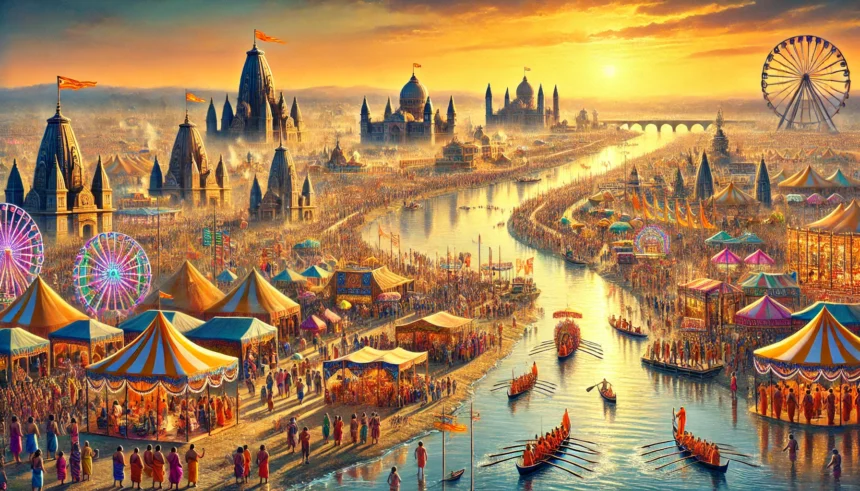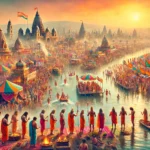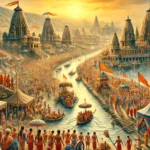Maha Kumbh Mela: The Spiritual Powerhouse of Prayagraj – 10 Key Facts and Insights
Kumbh Mela or The Maha Kumbh Mela, a spectacular and spiritually enriching event, is celebrated with great fervor in Prayagraj, India. Every 12 years, millions of devotees, pilgrims, and tourists from all over the world gather to take part in this grand festival, which is one of the largest peaceful gatherings in the world. But what makes this event so significant, and why does it happen in Prayagraj? Let’s delve deeper into the history, significance, and impact of the Maha Kumbh Mela on society.
History and Origins of Maha Kumbh Mela
The origins of the Kumbh Mela can be traced back to ancient Hindu mythology, specifically the “Samudra Manthan” (Churning of the Ocean). According to the legend, gods and demons fought for the nectar of immortality, known as “amrita.” In the process of this cosmic battle, a pot (Kumbh) containing the nectar was spilled at four places—Prayagraj, Haridwar, Ujjain, and Nashik. These places became the locations for the Kumbh Mela, with Prayagraj being the central focus of the Maha Kumbh every 12 years.
Why Prayagraj?
Prayagraj, formerly known as Allahabad, holds immense significance in Hinduism. It is where the three sacred rivers—Ganges, Yamuna, and the mythical Saraswati—converge, creating the holy “Triveni Sangam.” This confluence of waters is considered the most auspicious spot for performing rituals and bathing during the Kumbh Mela, as it is believed that taking a dip in the Sangam washes away sins and grants liberation (moksha).
Observance and Rituals
The Maha Kumbh Mela is an extraordinary spectacle, characterized by rituals, prayers, and spiritual acts. Devotees gather to take a ritual bath in the Sangam, a symbolic purification of the body and soul. The bathing dates are determined based on specific astrological alignments, and these timings are believed to be especially auspicious. Spiritual discourses, cultural performances, and the chanting of hymns fill the air, fostering a sense of unity and devotion.
The festival also involves the congregation of sadhus, or ascetics, who take part in grand processions, often walking through the streets adorned in orange robes. The most revered among them are the Naga sadhus, who are known for their austere and unique lifestyle. The Kumbh Mela also witnesses various religious rituals, including “pujas” (prayers), fire offerings, and religious discourses, making it a true spiritual feast for the soul.
Impact on Daily Life
The Maha Kumbh Mela has a profound impact on the local community in Prayagraj. For locals, the event brings a surge of economic activity, as millions of visitors from different parts of India and abroad arrive for the occasion. Small businesses, hospitality services, and transportation systems thrive during this period. Local artisans and food vendors also see an increase in their sales, and the city itself is transformed into a bustling spiritual hub.
Beyond the economic impact, the Mela has a cultural influence, bringing together people from all walks of life. It promotes religious tolerance and unity, as devotees from different faiths come together to observe the rituals, creating a sense of solidarity among the participants. It serves as a reminder of India’s rich cultural and spiritual heritage.
Significance and Importance to Society
The Maha Kumbh Mela plays a crucial role in preserving Hindu culture and traditions. For many participants, it’s an opportunity to reconnect with their spiritual roots, reflect on their lives, and purify their souls. The event acts as a significant reminder of the power of faith, devotion, and community spirit.
The Kumbh Mela also has a broader societal impact. It serves as a platform for discussing social and spiritual issues, while highlighting the importance of environmental conservation. Initiatives such as cleaning the rivers, promoting sustainability, and ensuring the safety and health of the pilgrims are integral to the event’s observance.
Moreover, the gathering reinforces the values of harmony, peace, and collective consciousness. It is an annual reminder that despite our differences, people can come together for a common spiritual cause, reinforcing unity in diversity.
10 Key Facts You Should Know
- Timing: The Maha Kumbh Mela occurs every 12 years at Prayagraj.
- Spiritual Importance: It is believed that bathing in the Triveni Sangam cleanses one’s sins.
- Massive Gatherings: Over 100 million people attended the 2013 Maha Kumbh Mela.
- Astronomical Significance: The date of the Mela is determined by astrological calculations.
- Naga Sadhus: The Naga sadhus are revered ascetics who participate in grand processions.
- Sacred Rituals: The Mela is known for spiritual discourses, fire offerings, and prayers.
- Cultural Performances: Folk dances, music, and other performances are an integral part of the celebration.
- Economic Impact: The Mela boosts local economies, particularly in hospitality and tourism.
- Unity in Diversity: It attracts people from different parts of India and the world, fostering communal harmony.
- Environmental Efforts: The event places great emphasis on the cleanliness of the rivers and the surrounding areas.
Frequently Asked Questions (FAQs)
Q1: How long does the Maha Kumbh Mela last? The Maha Kumbh Mela usually lasts for about 45 days, with the most significant bathing days occurring on auspicious dates.
Q2: What makes Prayagraj the main location for Maha Kumbh? Prayagraj is considered the most important venue because it is home to the confluence of three rivers: the Ganges, Yamuna, and Saraswati.
Q3: Is the Maha Kumbh Mela only for Hindus? While it is a Hindu religious event, people from all faiths are welcome to attend and experience the spiritual atmosphere.
Conclusion
The Maha Kumbh Mela is not just a religious event; it is a celebration of faith, community, and spiritual awakening. For millions, it is an opportunity to seek blessings, cleanse their souls, and reflect on life. Whether you’re participating in the rituals or simply experiencing the vibrant culture, the Maha Kumbh Mela leaves a lasting impression on all who visit. It stands as a powerful reminder of the enduring connection between the physical and spiritual realms, making it one of the most profound gatherings in the world.










